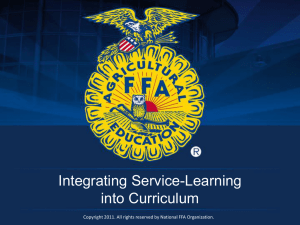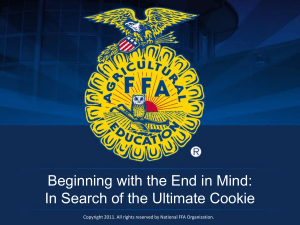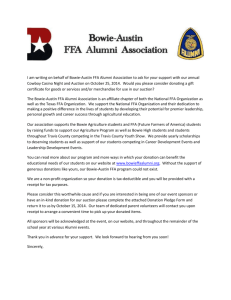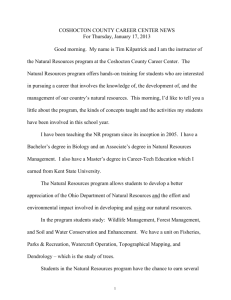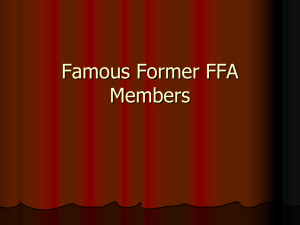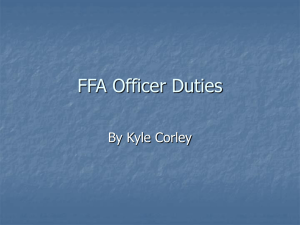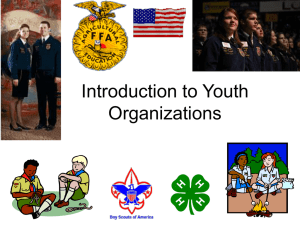Plant Exam Study Guide Review
advertisement
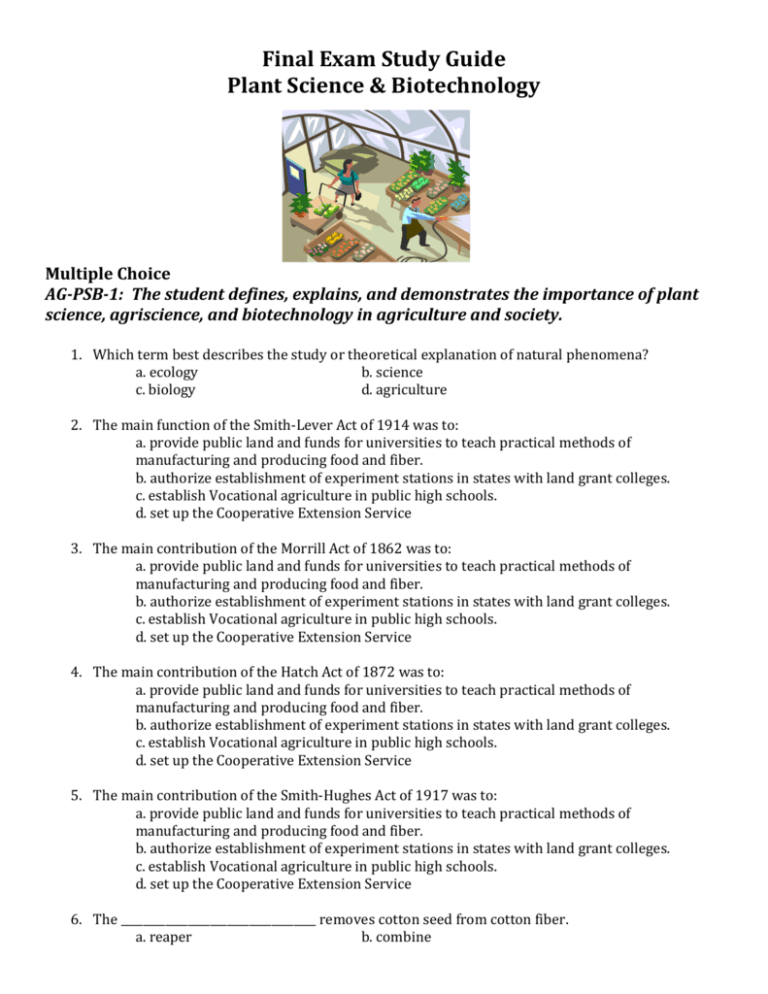
Final Exam Study Guide Plant Science & Biotechnology Multiple Choice AG-PSB-1: The student defines, explains, and demonstrates the importance of plant science, agriscience, and biotechnology in agriculture and society. 1. Which term best describes the study or theoretical explanation of natural phenomena? a. ecology b. science c. biology d. agriculture 2. The main function of the Smith-Lever Act of 1914 was to: a. provide public land and funds for universities to teach practical methods of manufacturing and producing food and fiber. b. authorize establishment of experiment stations in states with land grant colleges. c. establish Vocational agriculture in public high schools. d. set up the Cooperative Extension Service 3. The main contribution of the Morrill Act of 1862 was to: a. provide public land and funds for universities to teach practical methods of manufacturing and producing food and fiber. b. authorize establishment of experiment stations in states with land grant colleges. c. establish Vocational agriculture in public high schools. d. set up the Cooperative Extension Service 4. The main contribution of the Hatch Act of 1872 was to: a. provide public land and funds for universities to teach practical methods of manufacturing and producing food and fiber. b. authorize establishment of experiment stations in states with land grant colleges. c. establish Vocational agriculture in public high schools. d. set up the Cooperative Extension Service 5. The main contribution of the Smith-Hughes Act of 1917 was to: a. provide public land and funds for universities to teach practical methods of manufacturing and producing food and fiber. b. authorize establishment of experiment stations in states with land grant colleges. c. establish Vocational agriculture in public high schools. d. set up the Cooperative Extension Service 6. The ___________________________________ removes cotton seed from cotton fiber. a. reaper b. combine c. cotton gin d. tractor 7. The ___________________________________ removes ears of corn from stalks. a. reaper b. combine c. cotton gin d. tractor 8. The source of power for belt-driven machines: a. Reaper b. combine c. cotton gin d. tractor 9. The USDA stands for: a. United States Division of Agriculture b. United States Department of Agriculture c. United Standards of Demarcation in America d. United States Development of Agriculture 10. The three basic of life include a. sleeping, eating, and drinking c. food, shelter, and clothing 11. The Greek work bios mean? a. life c. environment b. knowledge, work, and leisure d. vitamins, minerals, and protein b. study d. nature AG-PSB-2: The student differentiates between plants utilizing scientific plant classification. 12. What is the order of scientific classification? a. Kingdom, phyla, class, order, family, genus, species b. Kingdom, class, order, phyla, family, species, genus c. Phyla, kingdom, class, order, family, genus, species d. Kingdom, order, class, phyla, family, species, genus 13. ____________________________ is the taxonomic category between family and species. a. genus b. division c. class d. kingdom 14. The science, laws, and principles of classifying organisms is known as _______________________. a. classification b. taxonomy c. labeling d. organization AG-PSB-3: The student identifies major structures of plants and describes their functions. 15. The area of cell division on a root is a the __________________________________. a. apical meristem b. root hairs c. phloem d. xylem 16. In plant breeding, what is removed from the plant to prevent natural pollination? a. anther sac c. style b. petals d. stigma 17. ____________________________ is the union of the pollen and the stigma. a. flower b. style c. pollination d. fertilization 18. The ovary of a flower matures into a. a seed c. a vegetable b. a fruit d. a new plant 19. Which of the following is NOT a major structure of plants: a. roots b. stem e. all of the above are major structures c. flower d. leaves AG-PSB-4: The student identifies the parts of plant cells and demonstrates their growth and solute movements. 20. Plants cells differ from animal cells in that they have: a. a mitochondria b. nucleus c. cell wall d. flagella 21. Cacti usually have some type of ___________________ whereas succulents do not. a. woody stem b. needles c. cones d. hairs AG-PSB-5: The student explains the technological advancements in plant development, reproduction, and protection. 22. What is a viroid? a. protein virus b. virus that is made of RNA and affects plants c. virus that is made of DNA and affects plants d. a synthetic virus 23. Another word for micropropagation is ____________________________________. a. air layering c. large propagation b. tissue culture d. grafting AG-PSB-6: The student identifies and describes plant nutritional needs, essential nutrients, and prescribes nutritional programs for plants. 24. How many elements are essential for plant growth? a. 3 b. 10 c. 16 d. 27 25. Plant ________________________________ is the process of adding nutrients to the soil or leaves. a. propagation c. reproduction b. fertilization d. none of the above 26. If a plant is deficient in ______________________________________ the entire plant will turn yellow. a. calcium c. nitrogen b. sulfur d. potassium 27. On a bag of fertilizer the middle number represents: a. the amount of potassium c. the amount of chloride b. the amount of phosphorus d. the amount of nitrogen 28. ___________________________________ is responsible for making the leaves green in color. a. calcium c. nitrogen b. magnesium d. potassium 29. _________________________________ is important for seedling and young plant growth. a. calcium c. nitrogen b. phosphorus d. potassium AG-PSB-7: The student evaluates soil characteristics, factors and components that influence plant growth and evaluates land plots and soil types for production capability. 30. How does day length affect plant growth? a. the water that is available to plants becomes greater at night b. the length of day means more photosynthesis taking place c. the death of the plant occurs at night d. nothing is affected 31. ______________________________________ is the wearing a way of land. a. evaporation c. potable b. erosion d. aquifer AG-PSB-8: The student diagrams the life cycles of plants explains the functions of plant reproductive parts and demonstrates methods of seed dissemination and germination. 32. This propagation technique cuts the leaf without taking the petiole. a. leaf petiole cuttings c. leaf cuttings b. double eye cuttings d. split vein cuttings 33. This propagation technique a stem is girdled with two cuts 1 inch apart, bark is removed, wound dusted with rooting hormone and damp sphagnum moss put around, then plastic around moss and tied at both ends. a. tip layering c. simple layering b. air layering d. advanced layering 34. _______________________________ propagation is less expensive. a. sexual b. asexual AG-PSB-9: The student explains the use and importance of genetics in plant breeding. 35. Who is considered the father of heredity? a. Gregor Mendel c. Fancis Clark b. James Watson d. Charles Darwin 36. Two alleles are homozygous. This means that the trait on each chromosome is: a. the same c. mixed b. different d. does not matter AG-PSB-10: The student describes the environmental effects on plants, demonstrates ways to manage the environment for production and ornamental use of plants, and match plants to given growing conditions. 37. Identify the most crucial factor to consider when growing indoor plants. a. food c. temperature b. weather d. light AG-PSB-11: The student explains the uses of plants in medicine, food crops, animal feeds, and ornamental applications. 38. Which of the following is the plant source of linseed oil? a. hay c. flax b. wheat d. corn 39. Corn has been modified to suit our needs. For example, we now have: a. popcorn varieties c. sweet corn varities b. grain corn varieties d. all of the above e. none of the above—all corn is the same AG-PSB-12: The student propagates plants using methods of vegetative cloning and sexual reproduction. 40. The embryo is always located in the same location, regardless of the type of seed. a. True b. False 41. The union of a small piece of bark with a bud and a rootstock is called ___________________________. a. spud b. bud c. seed d. grafting AG-PSB-13: The student identifies and classifies weeds, prescribes control methods, and describes the economic and environmental effects that weeds have on agricultural production. 42. Pesticides can reduce the risk of disease from natural toxins that exist in plants. a. True b. False 43. Organisms used in substituting biological for chemical pesticides include a. bacteria c. fungi b. viruses d. all of the above 44. Algaecides kill __________________________________. a. fungi c. algae b. weeds d. snails 45. Which of the following is NOT a benefit of using pesticides? a. increased yields of food and fiber b. reduced loss of stored products c. economic stability d. all of the above are benefits 46. Which of the following is NOT a way a pesticide, herbicide, or fungicide can become a pollutant? a. drift c. soil leaching b. drinking d. improper application AG-PSB-14: The student identifies, determines control methods, and defines the environmental and economic impact that insects have on plant production. 47. Biological control of pests involves using ______________________ as a control. a. people c. predators b. tilling d. pesticides 48. Insecticides kill _________________________________. a. fungi c. algae b. insects d. birds AG-PSB-15: The student identifies diseases, related organisms, and physiological disorders affecting plants, and prescribes methods of prevention and control. 49. Citrus growers and the US Horticultural Research Laboratory have been studying the disease, citrus blight, since: a. 1995 c. 1892 b. 1900 d. 1800 50. Citrus blight, a disease of citrus trees, a. may have no symptoms b. does not usually kill the tree c. is a harmless disease to the tree d. has a treatment but no cure. 51. The Hemlock Wooly Adelgid has attacked the _______________________________________ of North Carolina. a. Hemlock insect c. Hemlock trees b. Hemlock roses d. Hemlock vines AG-PSB-16: The student explains the water-plant relationship and describes how water and other materials move through the plant. 52. Plants that growing in water receives much of their oxygen from the water. a. True b. False 53. Phloem carries nutrients _________________________ the plant. a. up b. down 54. Xylem carries nutrients ___________________________ the plant. a. up b. down AG-PSB-17: The student describes environmentally controlled plant growth systems and prescribes their use based on plant environmental needs and economic factors. 55. A greenhouse is a ______________________________________ environment. a. controlled b. uncontrolled 56. The HAF in the greenhouse regulates: a. the flow of air into the greenhouse b. the flow of air inside the greenhouse c. the temperature inside the greenhouse d. the water in the air 57. The purpose of the shade cloth is to _________________________ light rays from the sun. a. inseminate c. attract b. disperse d. reflect 58. What is the number one reason for keeping a greenhouse clean? a. bacteria growth c. contamination of plant material b. control of the area d. all of the above are correct AG-PSB-18: The student analyzes the affect of plant production on the environment and quality of life factors. 59. Plants that live for more than two growing seasons are called: a. annuals c. perennials b. biannuals d. triannuals 60. Plants that live for one year are called: a. annuals b. biannuals c. perennials d. triannuals 61. Plants that live for two growing seasons are called: a. annuals c. perennials b. biannuals d. triannuals 62. The pH range for most vegetable crops is 5.5-7.5. a. True b. False 63. A compound leaf is made up of: a. more than one leaf b. a leaf that has divided into two halves c. a leaf that has divided into a whorled arrangement d. three to seven leaflets 64. Identify the leaf arrangement to the stem: a. opposite b. whorled c. awkward d. alternate AG-BAS-19: The student becomes oriented to the comprehensive program of agricultural education, learns to work safely in the agriculture lab and work sites, demonstrates selected competencies in leadership through the FFA and agricultural industry organizations, and develops plants for a supervised agricultural experience program (SAEP). 65. What year was the FFA organization founded? a. 1927 b. 1928 c. 1942 d. 1938 e. 1922 66. What are the official FFA colors? a. blue & gold c. national blue & corn gold e. gold b. red and yellow d. American blue & corn yellow 67. The FFA motto is: “Learning to do, __________________, earning to live, living to serve.” a. doing to learn b. doing to serve c. doing to earn d. doing to live e. doing 68. FFA makes a positive difference in the lives of students by developing their potential for ______________ leadership, ______________ growth, and ______________ success. a. career, learn, live b. premier, personal, career e. personal c. personal, career, premier d. career, premier, personal 69. The president in an official FFA meeting is stationed across from the: a. advisor b. secretary b. treasurer d. vice president 70. SAEP stands for: a. supervised agriculture experience project b. supervised agriculture experience program e. president c. supervised agriculture experience partnership d. supervised agriculture extra program e. none of the above 71. Two taps of the gavel is done in meeting to: a. get members to stand b. get members to sit c. restores order d. calls meeting to order e. adjourn 72. The motion, “lay on the table” requires a ____________ vote. a. two-thirds b. majority c. voice d. rising e. minority 73. A ____________________ is when half or more members are present. a. simple majority b. quorum c. majority d. reconsider e. two-thirds 74. What year were girls allowed to join FFA? a. 1965 b. 1948 c. 1969 d. 1928 75. What is the first degree received by FFA members in the 9th grade? a. Discovery b. Greenhand c. State d. American 76. The secretary of the FFA organization is represented by what symbol? a. owl b. ear of corn c. blue jay d. sun 77. The National FFA Center is in __________________________________________. a. Louisville, Kentucky b. Atlanta, Georgia c. Denver, Colorado d. Indianapolis, Indiana 78. The law that established FFA as an organization in high school was: a. Smith Hughes Act b. Smith-Lever Act c. Public Law 740 d. Public Law 470 79. The NFA and FFA merged in: a. 1993 c. 1969 b. 1928 d. 1965 80. The FFA Organization is only for people who want to be farmers. a. True b. False

